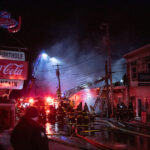Charleston, S.C. and Jacksonville, Fla. are two of five cities NOAA National Hurricane Center forecasters and NOAA Aircraft Operations Center crew will visit during a May 2-6, five-day mission.
The purpose of the tour is to increase hurricane awareness; encourage preparedness in vulnerable East Coast coastal and inland communities; and to publicize May 15 to 21 National Hurricane Preparedness Week. Other cities on the route include: Cities on the route: Bangor, Maine; Baltimore, Md.; and Richmond, Va.
The team of hurricane experts, aided by local NOAA National Weather Service officials, will ride a WP-3 Orion four-engine turboprop, nicknamed “Miss Piggy,” to meet emergency managers, media and the public.
“Every hurricane season, brave men and women board ‘hurricane hunter’ aircraft from NOAA and the Air Force Reserve to fly into storms and gather data that is critical to producing accurate track and intensity forecasts of the storm,” retired Air Force Brig. Gen. David L. Johnson, NOAA National Weather Service director said. “I invite the public to meet and greet the best of the best and take to heart their important safety messages.”
Max Mayfield, director of the NOAA National Hurricane Center said, “Our objective is straightforward: increase awareness of the hurricane threat for a population relatively inexperienced with hurricanes. Most important, we want to share lessons learned last year when four hurricanes affected Florida.”
“The 2004 Atlantic hurricane season was among the most devastating on record,” Mayfield explained. “More than 3,100 lives were lost in Haiti, the second largest Atlantic toll in three decades. In the United States, 60 direct deaths were associated with tropical storms and hurricanes.”
At least 92 indirect fatalities occurred last year in Florida alone. Factors leading to such deaths included carbon monoxide poisoning from inadequate ventilation for generators, fires from improper use of candles and traffic accidents due to toppled street lights and stop signs.
“One lesson that bears emphasizing is that loss of life both during and after the hurricane can be prevented with education and a little common sense,” Mayfield said.
“Inland flooding and poor human judgment continues to be a lethal combination,” Dean P. Gulezian, director of the NOAA National Weather Service Eastern Region said. “Last year, the remnants of the small hurricane, Gaston, dropped more than 12 inches of rain in the Richmond, Va., area causing eight deaths. Five of these were motorists attempting to drive through flooded roadways.”
Was this article valuable?
Here are more articles you may enjoy.


 Louvre Tightens Security After $102M Jewel Heist, Installs Bars on Infamous Window
Louvre Tightens Security After $102M Jewel Heist, Installs Bars on Infamous Window  Longtime Motel 6 Spokesman Tom Bodett Settles Lawsuit Against Chain
Longtime Motel 6 Spokesman Tom Bodett Settles Lawsuit Against Chain  Fire Damages Portland, Maine’s Historic Waterfront
Fire Damages Portland, Maine’s Historic Waterfront  Head of EEOC Urges White Men to Report Discrimination
Head of EEOC Urges White Men to Report Discrimination 

